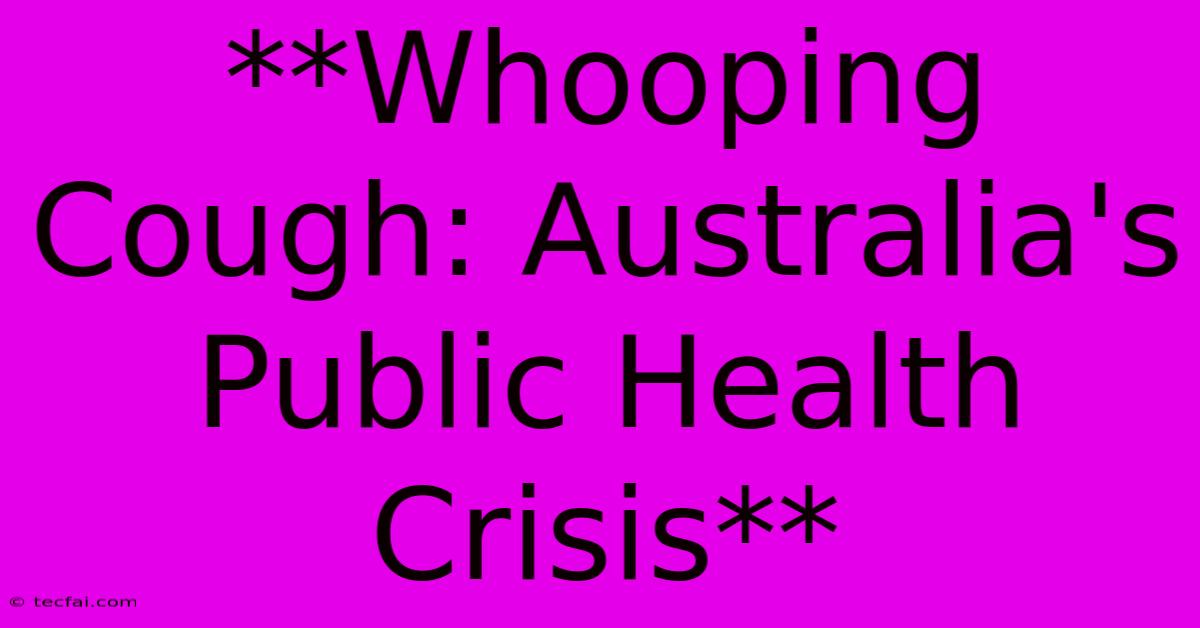**Whooping Cough: Australia's Public Health Crisis**

Discover more detailed and exciting information on our website. Click the link below to start your adventure: Visit Best Website tecfai.com. Don't miss out!
Table of Contents
Whooping Cough: Australia's Public Health Crisis
Whooping cough, also known as pertussis, is a highly contagious respiratory infection that poses a significant threat to public health in Australia. Despite the availability of effective vaccines, the number of cases has been steadily rising in recent years, causing concern among health authorities and prompting calls for increased awareness and preventative measures.
The Threat of Whooping Cough in Australia
High Incidence and Mortality Rates: Australia experiences a cyclical pattern of whooping cough outbreaks, with a notable surge in cases every three to five years. In 2022, the nation witnessed its highest number of reported cases in over a decade, highlighting the ongoing vulnerability of the population. While the majority of cases are mild, the disease can be particularly dangerous for infants, young children, and individuals with weakened immune systems, potentially leading to serious complications such as pneumonia, seizures, brain damage, and even death.
A Growing Concern: The resurgence of whooping cough is attributed to a combination of factors, including declining vaccine coverage, waning immunity over time, and the emergence of new strains of the bacteria. While the vaccination program remains a vital defense against the disease, the effectiveness of the vaccine wanes over time, requiring booster doses to maintain sufficient protection. Moreover, the rapid spread of the disease among unvaccinated individuals can lead to outbreaks that overwhelm healthcare systems and put vulnerable populations at risk.
Understanding Whooping Cough
Causes and Transmission: Whooping cough is caused by the bacterium Bordetella pertussis, which spreads through respiratory droplets released when an infected person coughs or sneezes. The bacteria can linger in the air for several hours, making it easy for others to inhale and contract the disease.
Symptoms: The characteristic symptom of whooping cough is a forceful cough that can last for several weeks, followed by a high-pitched "whoop" sound as the person struggles to inhale. Other common symptoms include runny nose, sneezing, fever, and fatigue. While infants may not exhibit the distinctive whoop sound, they are particularly susceptible to severe complications and require immediate medical attention.
Diagnosis and Treatment: Whooping cough is diagnosed based on clinical presentation and laboratory testing, which can confirm the presence of the bacteria. Treatment typically involves antibiotics to reduce the duration of the illness and minimize the risk of complications. However, it is essential to note that antibiotics are not effective in preventing the spread of the disease.
Strategies for Prevention and Control
Vaccination: The most effective way to prevent whooping cough is through vaccination. The pertussis vaccine is highly effective in reducing the risk of infection and severe complications. Australia's National Immunisation Program (NIP) offers free pertussis vaccines for infants, children, adolescents, and adults, with booster doses recommended at specific intervals.
Early Diagnosis and Treatment: Prompt diagnosis and treatment are crucial for minimizing the severity of whooping cough and preventing its spread. If you or your child experiences symptoms suggestive of the disease, seek medical attention immediately.
Public Health Measures: Public health measures play a vital role in controlling whooping cough outbreaks. These include isolation of infected individuals, quarantine of close contacts, and education campaigns to promote awareness and encourage vaccination.
The Importance of Collective Action
Whooping cough is a serious public health challenge that requires a collective effort to address. It is essential for individuals, healthcare providers, and policymakers to work together to implement effective prevention and control strategies. By increasing vaccination rates, promoting early diagnosis and treatment, and adopting comprehensive public health measures, we can significantly reduce the burden of this preventable disease on our communities.
Conclusion: Whooping cough remains a persistent threat to public health in Australia, with a rising incidence of cases and potential for serious complications. While the vaccine remains the most effective weapon in our arsenal, ongoing vigilance and collaborative efforts are essential to mitigate the impact of this preventable disease. Through responsible vaccination, early diagnosis and treatment, and robust public health measures, we can protect ourselves and our communities from the devastating effects of whooping cough.

Thank you for visiting our website wich cover about **Whooping Cough: Australia's Public Health Crisis** . We hope the information provided has been useful to you. Feel free to contact us if you have any questions or need further assistance. See you next time and dont miss to bookmark.
Featured Posts
-
Postgame Recap Ravens Defeat Bengals 35 34
Nov 08, 2024
-
Ken Chan Mindset Ang Tanging Sandata
Nov 08, 2024
-
Cant Buy A Goal Oilers Off To Slow Start
Nov 08, 2024
-
Aclu On Trumps Potential January White House Return
Nov 08, 2024
-
Calgary Lines Up For New Chick Fil A Opening
Nov 08, 2024
